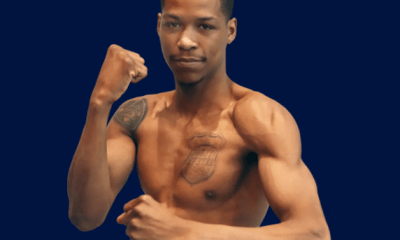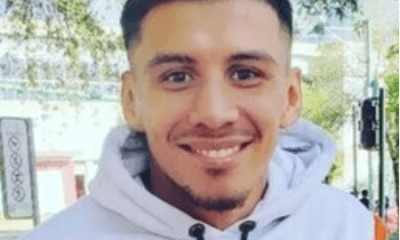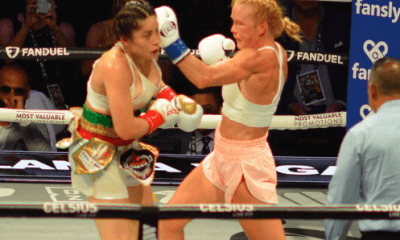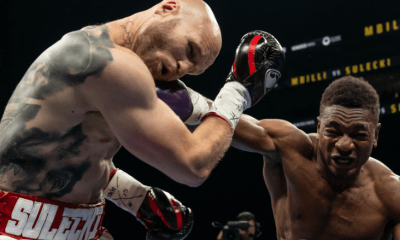Featured Articles
The Case for Marlon Starling: Why “Moochie” Belongs in Canastota
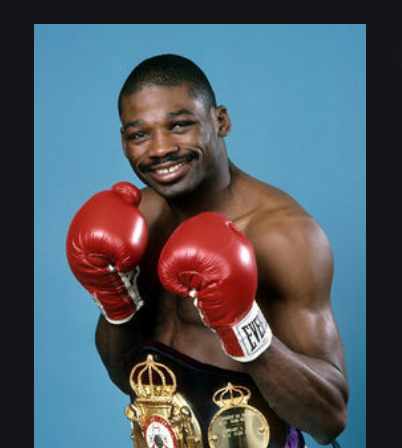
The Case for Marlon Starling: Why “Moochie” Belongs in Canastota
A TSS CLASSIC — It’s hard for the typical fight fan to understand exactly what the current criteria are for induction into the International Boxing Hall of Fame. Boxing, unlike baseball or professional football, does not rely on a cold and calculated interpretation of statistics to determine eligibility and induction. It’s much more complicated than that. Or far more simple, depending on how you look at it. In our sport, the observer has real power. Greatness is in the eye of the individual beholder. What he or she sees, thinks, and does — matters.
Don’t believe me? Consider any split or majority decision.
According to their website, the mission of the IBHOF (located in upstate Canastota, New York since 1989) is, among other things, to “chronicle the achievements of those who excelled” in boxing. A closer look at the site reveals more about their procedures: “Members of the Boxing Writers Association of America and an international panel of boxing historians cast votes. Voters from Japan, England, Canada, Mexico, South Africa, Germany, Puerto Rico and the United States are among those who participate in the election process.”
I’ve been to the IBHOF many times and the Brophys, Director Ed and historian nephew Jeff, do a great job along with their loyal President Don Ackerman. In recent years, however, the Hall, and some of its young new voters in particular, have come under fire for their selection of some less than unanimous choices such as Arturo Gatti, “Boom Boom” Mancini, and Riddick Bowe. Critics and dissenters point to their losses and other perceived shortcomings while those who voted for them must surely have had their focus on the achievements and fame of those they ultimately helped to enshrine.
Personally, I’d have voted for two of three but that’s just me.
Enter Marlon “Magic Man” Starling, the former undisputed welterweight champion of the world from Hartford, Connecticut. Starling retired from boxing in 1990, a year after the establishment of boxing’s first true hall of fame. In those twenty-five plus years, Starling’s name has yet to appear on the ballot for IBHOF voters to either vote for or not. Before discussing Starling’s qualifications, let me make one thing clear about the balloting process. It’s a closed one. What that means is that a small group of IBHOF insiders figuratively pick names from a hat and then put those choices on the official ballot for the public consideration of their various international voters. Arturo Gatti, for example, could not have been voted for and voted in had his name not been selected by this panel in the first place. The identity and decision making process of this internal group remains a mystery to most outsiders.
They hold the 24K gold key to induction.
Why then would they want to put Starling’s name on the ballot? Well, for starters, theirs is a hall of fame, not a hall of feints. Starling was actually a master of both. When Starling plied his craft in the competitive cauldron of the 1980s, he frequently appeared on network television in primetime. It was there that mainstream fight fans got to know “Moochie” and his “Starling Stomp” signature move. In televised battles against Donald “Cobra” Curry, Jose “The Threat” Baret, and Johnny “Bump City” Bumphus among so many others, Starling made an unforgettable impression on a generation of fans who still remember him today and must wonder why he’s not in the hall if lesser skilled pugilists are. The IBHOF’s inclusion of Gatti could be seen just as controversially as the exclusion of Starling.
Compiling a career record of 45-6-1 (27), Starling made his pro debut in 1979 after an inauspicious amateur career where he lost in Lowell, Mass to Robbie Sims of all people. As a professional prizefighter inspired by the late great Muhammad Ali, Starling had a defensive peek-a-boo style that made him very difficult to hit, let alone beat. Not unlike Ali, Starling also possessed the gift of gab.
The young welterweight ran his record to 25-0 before his first loss, a twelve round split decision to Donald Curry in 1982. To this day, Starling disputes that subjective defeat just as he disputes his lack of inclusion in the hall of fame where he is regularly a guest of honor during annual induction weekends. “The Hall of Fame is special. I think Marlon Starling does belong in there,” says Starling about Starling. Even more ironically, “Cobra” Curry is also still waiting for a call from the hall that might never come. Curry’s qualifications include having been the single best pound-for-pound boxer on the planet for a short period of time, but that’s a debate for another day. (Editor’s Note: Since this story was written, Curry received the call, entering the Canastota shrine with the class of 2019.)
From 1983 to 1986, Starling stayed busy in search of a big money superfight against the likes of Sugar Ray Leonard or Tommy Hearns. Neither match-up was meant to be for “Moochie” who had to settle for televised bouts against contenders Kevin Howard, Floyd Mayweather Sr., and Simon Brown, all of whom Starling defeated by decision. “I have the respect of the Big Four. That’s what matters to me,” says Starling of Leonard, Hearns, Marvelous Marvin Hagler, and Roberto Duran. “Whenever I see those guys, I get their respect.”
A February 1984 rematch against a prime Donald Curry ended in the disappointment of another decision loss for Starling. It was in 1987 however that Starling began to make the most of the opportunities coming his way. A televised shot at the WBA welterweight championship against legendary amateur Mark Breland was all that stood between Starling and the world welterweight title. Following a virtuoso performance from Starling that highlighted the vast difference between a seasoned pro and a professionally inexperienced amateur, Breland collapsed in the eleventh round and just like that Starling was champion of the “whole wide world” as he proudly told Alex Wallau on ABC after the win.
In actuality, Starling was not yet the man who beat the man because of somebody out there named Lloyd Honeyghan. It was Honeyghan who upset Donald Curry for the world welterweight championship in 1986 and before Starling could move to unify or win universal recognition by beating Honeyghan, he’d have to go through the politics of a rematch “draw” with Breland (one judge scored the fight for Starling as did most fans and media) and a strange (again televised) knockout loss-turned-no contest (NC) against Tomas Molinares in 1988. Starling was knocked absolutely senseless from a punch that clearly landed after the bell to end the fifth round. Though it was later ruled a no contest and the result nullified, Starling lost his WBA championship and his momentum. Worse, he was made to look like a fool by HBO’s Larry Merchant during the unforgettably uncomfortable post-fight interview where Starling claimed that not only wasn’t he knocked out, he was never even knocked down.
It looked like the end was near for Marlon Starling.
But like a Phoenix rising from the ashes, Starling’s best days were still ahead of him. Less than a year after the Molinares debacle, Starling received a shot at Lloyd Honeyghan. Because Honeyghan had so thoroughly thrashed Curry to win the WBC welterweight title, few observers expected “Moochie” to emerge victorious, particularly after his brutal “knockout” by Molinares. Boxing the fight of his life, Starling totally dominated and embarrassed Honeyghan, stopping the puffy “Ragamuffin Man” in nine rounds to lay claim to the undisputed world welterweight championship. By fighting and defeating the very best in the world, Starling had achieved his career goal of becoming the best welterweight in the world, the true welterweight champion of the “whole wide world.”
After reaching his professional peak with the thumping of Honeyghan, Starling defended the championship once before an ill-fated, economically driven, move to middleweight where he came up short against defending 160-pound world champion Michael Nunn, losing by majority decision. One judge scored it a perfectly even draw, 114-114 while two others had Nunn winning by wide scores.
In his final bout, Starling returned to welterweight where he dropped the 147-pound world title to Maurice Blocker by a majority decision before retiring in 1990, never to return, forever young in the eyes of those who saw him box under the bright lights of commercial network exposure. Again, another judge saw it all even in what was a very close fight in the ring and on the final scorecards.
So, does Marlon Starling belong in the International Boxing Hall of Fame? I’d say he does. I asked Starling himself and he answered me with a question. “How can Riddick Bowe be in the Hall of Fame if Marlon Starling isn’t?” he said in his uniquely rhetorical third-person fashion. Still, that’s not the path to Canastota, even if by all accounts Starling should at least be on the ballot by now.
You see, boxing is, like most everything else where so much money and power is involved, very political. Being outspoken, like Starling is and always has been, can hurt you in this game. Rightly or wrongly, it can prevent you from getting where you want to go. As a fight writer, I have experienced it personally and I have seen it applied to some brave souls who make their living in this, the cruelest sport.
Marlon Starling was a master defensive fighter. He won the legitimate world championship of the welterweight division, putting himself on a straight line that can trace its lineage all the way back to Sugar Ray Robinson, the best to ever lace up a pair of gloves. Starling was a TV star during the glory days of Wide World of Sports and Saturday afternoon boxing for the masses. Starling overcame strange and controversial defeats to persevere where few expected he could or would. Starling’s outgoing and accessible personality endeared him to fans and it’s good to see that nothing has changed.
Starling, who will turn 62 (not 61 as widely reported) on Aug. 29, 2020, is still sharp as a tack because boxing is about hitting and not getting hit. Starling still communicates with his many fans and makes himself available at boxing events for them to meet and greet him. In the end, Starling made his mark of excellence on the sport he chose to compete in and he did so in a way that made an indelible impression on all those who saw him fight.
Hope to see you in Canastota someday, Champ.
This is a slightly modified version of a story that ran on these pages on Aug. 29, 2016. Jeffrey Freeman covers boxing in New England for The Sweet Science.
Check out more boxing news on video at The Boxing Channel
To comment on this story in The Fight Forum CLICK HERE
-

 Featured Articles3 weeks ago
Featured Articles3 weeks agoAvila Perspective, Chap. 330: Matchroom in New York plus the Latest on Canelo-Crawford
-

 Featured Articles2 weeks ago
Featured Articles2 weeks agoVito Mielnicki Jr Whitewashes Kamil Gardzielik Before the Home Folks in Newark
-

 Featured Articles4 weeks ago
Featured Articles4 weeks agoAvila Perspective, Chap 329: Pacquiao is Back, Fabio in England and More
-

 Featured Articles3 weeks ago
Featured Articles3 weeks agoOpetaia and Nakatani Crush Overmatched Foes, Capping Off a Wild Boxing Weekend
-

 Featured Articles2 weeks ago
Featured Articles2 weeks agoCatching Up with Clay Moyle Who Talks About His Massive Collection of Boxing Books
-

 Featured Articles4 weeks ago
Featured Articles4 weeks agoFabio Wardley Comes from Behind to KO Justis Huni
-

 Featured Articles1 week ago
Featured Articles1 week agoMore Medals for Hawaii’s Patricio Family at the USA Boxing Summer Festival
-

 Featured Articles4 weeks ago
Featured Articles4 weeks agoDelving into ‘Hoopla’ with Notes on Books by George Plimpton and Joyce Carol Oates

